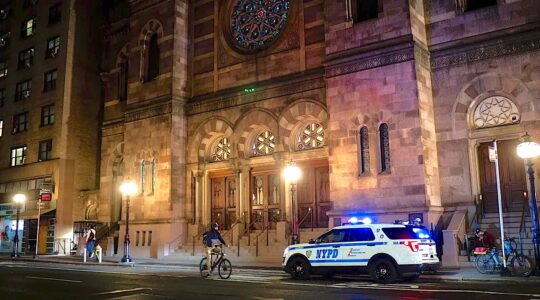To the iPad’s many functions — electronic reader, Internet browser, music player, camera, gaming console and interactive textbook — add this: discipline tool.
When Devorah Werdesheim, a teacher at Ohr Chadash Academy in Baltimore finds a student misbehaving, she merely has to temporarily confiscate the device, which all fourth-through-sixth graders at this Modern Orthodox school have.
Early in the year, on a rare occasion when a student was using his tablet computer for non-academic purposes, “I didn’t even have to say anything,” Werdesheim recalled. “I just went over there and said, ‘Sports, huh?’ And I took away the iPad and that was the end of it. No one wants their iPad taken away overnight.”
Ohr Chadash is one of a handful of Jewish day schools throughout the United States that are pioneering the iPad this year. Only two years old, iPads are still a rarity in most schools, although growing numbers of public and private schools are beginning to experiment with them. And with Apple’s launch last Thursday of iBooks2 for distributing interactive, digital K-12 textbooks, the number of schools purchasing these devices is poised to grow dramatically.
Proponents of bringing the iPad into schools rave about its versatility, portability, ease of use and ability to excite students.
But the devices bring challenges as well: they are fragile, expensive, awkward to type on and chock full of distractions, especially when connected to the Internet. And it is unclear whether — once its novelty wears off and if it becomes as commonplace as pencils and notebooks — the toy-like iPad will retain its magical power over children.
No one knows exactly how many Jewish day schools are using iPads, but The Jewish Week’s research turned up nine. Some, like suburban Detroit’s Frankel Jewish Academy, a pluralistic high school, have “one-to-one” programs in which each student and teacher has his/her own device. Others, like Baltimore’s Ohr Chadash, Meyer Academy (pluralistic) in West Palm Beach, Fla., and The Jewish Academy of Orlando (pluralistic) give iPads to each student, but only in the older grades. In the New York area, Manhattan’s Rodeph Sholom (Reform) and Paramus, N.J.’s Yeshivat Noam (Orthodox) are experimenting with iPads in all grades, but the students share them and do not take them home. Manhattan’s Ramaz (Orthodox), meanwhile, is testing out iPads by giving them to seven seventh graders who use the school’s “learning center” for assistance with learning “interferences.”
The Jewish Week found no Jewish schools using non-Apple tablet computers, which have so far failed to capture a sizable share of the commercial and educational markets.
♦
The iPad is “a mobile office, it’s a mobile classroom,” says Nammie Ichilov, head of the K-8 Meyer Jewish Academy, where all the middle school students have their own iPads and younger students access classroom iPads.
The 315-student school initially considered a one-to-one laptop program in the middle school, but then decided iPads would be less expensive (than the Macbooks the school was considering) and easier to use.
Asked why Ohr Chadash, a K-6 school that just opened this fall, wanted to bring in iPads, Noam Davidovics, the technology chair, says, “I’ve been in computers for a while, and the first time you see a child use an iPad it’s a eureka moment. For the first time, a computer is easier to use than a pen and paper to a child.”
Support the New York Jewish Week
Our nonprofit newsroom depends on readers like you. Make a donation now to support independent Jewish journalism in New York.
For officials at Detroit’s Frankel, the decision to go iPad stemmed from an ongoing commitment to being on the cutting edge technologically.
With the school about to upgrade its computers and technology director Patti Shayne convinced tablets would soon be the norm, it seemed like a good time to try the iPad.
So far, no one is expressing any regrets.
Rabbi Eric Grossman, Frankel’s head of school, says the iPad has already proven successful in helping to mainstream learning disabled students, making it easier to offer “individualized learning” and to help kids “with organizational difficulties” keep track of their homework and other assignments.
Susan Stein, coordinator of general studies at Ramaz’s middle school learning center, echoed that assessment, noting that the iPad is “a wonderful choice” for some kids with learning challenges.
“They don’t lose their papers, they don’t lose their notebooks, they don’t have to carry heavy backpacks. It helps keep them focused and organized.”
Poor readers can easily convert their reading material to large font, while others can listen to an audio download when they read, she says, adding that it’s “handy to have everything all in one place.”
However, of the seven Ramaz kids who tried out the iPad, two opted to use laptops instead, citing the difficulty of using the tablet’s on-screen keyboard.
The iPad is being used in both secular and Judaic studies.
Scheck Hillel Community Day School, in suburban Miami, is using the devices for a “paperless” Talmud class.
Seth Dimbert, the school’s director of learning technologies told JTA that teaching Talmud with an iPad has led to “increased levels of engagement, portability and space and cost savings.
“Normally, when you study the Talmud, each page is covered with cross-references and tertiary commentaries, and you have bookshelves filled with dozens or even hundreds of secondary reference texts,” he said. “Using an iPad application puts all of that reference material in hypertext. It’s an ideal way to study the Talmud, which is in some sense the original hypertext.”
Support the New York Jewish Week
Our nonprofit newsroom depends on readers like you. Make a donation now to support independent Jewish journalism in New York.
Many say the iPad — able to store an entire Judaic library — makes it much easier for students to search, read, translate, annotate and share Jewish texts.
“When you’re referring to a different perek [chapter] or mishna [section], you don’t have to make copies or give everyone a book,” says Ohr Chadash’s Davidovics. “Everyone has it on their iPad, right there.”
At Frankel, the iPad “has allowed us to turn into a much more collaborative community,” says Amira Gaba, a Bible teacher. She often breaks students into hevruta, or pairs, to translate texts on their iPads; using Google Forums, everyone submits their translations and the class can look at them all side by side.
Another useful feature is easy-to-make-and-share videos, which enables teachers to experiment with “flipped classrooms” — where students view explanatory lectures on their own and then use in-class time with teachers to ask questions and get help solving problems.
“If there’s a concept a student didn’t understand in class, they can take it home and play it over and over until they get it, as opposed to sitting in class where you might be too embarrassed to ask the teacher to repeat something,” says Rabbi Grossman of the videos.
Elisheva Erlanger, who teaches fifth and sixth grade at Ohr Chadash, says the iPad helps with “differentiating” — tailoring assignments to students’ abilities. “It used to be everyone saw what worksheets the others were getting,” she says. “Now I can write sheets, record into them, highlight things, make things bigger, move things around, and I’m able to do that more discreetly.”
While no one yet is giving younger children iPads to take home, many educators say classroom iPads can be a boon in the lower grades.
“It’s just the right size for an elementary school child to handle and to take with them when they sit on the floor,” says Linda Stock, assistant principal at Yeshivat Noam, which recently brought in an iPad cart that moves from class to class.
“Kids are so motivated when they get their hands on an iPad,” says Stock. “It’s our job to make sure that what they’re doing on there is worthwhile, tied to the curriculum and enhancing their educational time in school.”
♦
The iPad is hardly perfect. According to the Associated Press, the devices generally cost $500-600 apiece when purchased for schools — but that doesn’t include the expense (and labor time) of maintaining them, training teachers and students, operating a reliable wireless network and managing downloads and updates.
“We have an incredible tech assistant who enabled implementation to go smoothly, but schools really need to look at how they are going to push out applications and what they are going to use on the back end to make it manageable,” says Linda Dombchik, technology director of the Jewish Academy of Orlando, which has 150 students in grades k-8. “Just buying the devices and sticking them in the hands of students without support is very hard.”
Support the New York Jewish Week
Our nonprofit newsroom depends on readers like you. Make a donation now to support independent Jewish journalism in New York.
Schools need to think about technological infrastructure and make sure they have “acceptable use” policies in place, Frankel’s Shayne advises.
And, while the device is easy to learn, teachers still need time and training to use it effectively.
Several schools said they introduced the iPads to teachers at the end of last year, then let them spend the summer familiarizing themselves with the device. Both Rodeph Sholom, which has nursery through eighth grade, and Frankel have small cohorts of teachers who meet regularly, help research best ways to use the devices and share that information with the other teachers.
“This involves a complete rethinking of what a school is, what a classroom is and what a teacher is,” Rabbi Grossman says. “If you think you can import this into a traditional classroom, you’re going to waste technology or it’s going to be a disaster.”
Another challenge is that, while digital textbooks sound great, for now the offerings are fairly limited.
Meyer Academy, for example, has not been able to do away with printed textbooks, to the disappointment of parents who “thought this would eliminate heavy backpacks,” Ichilov says.
Then there are the myriad potential distractions in each 9.7-inch screen.
Frankel Academy’s Shayne says iPads “can be a distraction” (and students there told JTA they sometimes play “Words With Friends” in class) but it is “no different than a student being distracted in a different manner.”
Ohr Chadash’s Ehrlich says iPad abuse has been easier to deal with than she had initially expected, largely because the devices lie flat on the table, unlike laptop screens, and “I can easily see the screen as I circulate the room.”
Theft, damage and insurance premiums pose more drawbacks — with virtually every school reporting their students have already broken some iPads.
“If I were to do this again, I would’ve found a way to allocate the funds for better protective cases,” Shayne says.
Plus, the flip side of having everything in one place is that, without proper data backup, everything can be immediately lost.
Support the New York Jewish Week
Our nonprofit newsroom depends on readers like you. Make a donation now to support independent Jewish journalism in New York.
“My daughter learned that the hard way,” says Kimberly Morgan, the mother of a sixth grader at Meyer Academy. “A bunch of things got lost, then she learned how to back everything up onto the computer at home.”
♦
So far, parents and students seem pleased with the iPads.
One major benefit, parents report, is that it mitigates the homework battles — and some apps and teacher-made videos help answer the students’ questions when the parent is stumped.
“In the past she’d be groaning and moaning about homework,” Meyer Academy’s Morgan says of her daughter. “This makes homework a little more interesting.”
Ari and Esti Taragin say their son, a sixth grader at Ohr Chadash, now comes home “excited to do his homework.”
“Each grade has a place online where they can check what all the assignments are, so there’s no ‘I lost my looseleaf,’ ‘I don’t remember or ‘I have to call a friend.’ It’s all there,” says Ari Taragin.
The iPad has also instilled responsibility in their son, says Esti Taragin: “He takes care of charging it every night. He’s taking pride in it.”
Says Morgan of her daughter and her classmates at Meyer Academy: “They know they have to charge it overnight or they won’t be able to participate the next day — or, God forbid, they’ll have to use a pencil!”
JTA contributed to this article.
E-mail: Julie.inthemix@gmail.com. Next in the series: The live, online global Jewish classroom.
The New York Jewish Week brings you the stories behind the headlines, keeping you connected to Jewish life in New York. Help sustain the reporting you trust by donating today.




